Pope John II
Pope John II | |
|---|---|
| Papacy began | 2 January 533 |
| Papacy ended | 8 May 535 |
| Predecessor | Boniface II |
| Successor | Agapetus I |
| Personal details | |
| Born | Mercurius |
| Died | 8 May 535 Rome |
| Buried | St. Peter's Basilica |
| Other popes named John | |
Pope John II (Latin: Ioannes II; died 8 May 535), born Mercurius, was the bishop of Rome from 2 January 533 to his death. As a priest at St. Clement's Basilica, he endowed that church with gifts and commissioned stone carvings for it.
Early life

Mercurius was born in Rome, son of Praeiectus. He became a priest at St. Clement's Basilica on the Caelian Hill,[1] and even before becoming pope he had commissioned work for the basilica and made generous donations.[2] The basilica still retains memorials of "Johannes surnamed Mercurius";[1] he donated plutei and transennae.[3] A reference to "Presbyter Mercurius" is found on a fragment of an ancient ciborium. Several marble slabs that enclose the schola cantorum bear upon them, in the style of the sixth century, his monogram.[1]
Pontificate
Mercurius was elected pope on 2 January 533, apparently the first pope to adopt a new name upon elevation to the papacy.[1]
The notoriously adulterous behavior of Bishop Contumeliosus of Riez caused John to order the bishops of Gaul to confine him in a monastery.[4][5] Until a new bishop could be appointed, he bade the clergy of Riez to obey the Bishop of Arles.[1]
Arianism
In 535, two hundred and seventeen bishops assembled in a council at Carthage submitted to John II a decision about whether bishops who had lapsed into Arianism should, on repentance, keep their rank or be admitted only to lay communion. The question of re-admittance to the lapsed troubled north Africa for centuries (see Novatianism and Donatism). The answer to their question was given by Agapetus I, as John II died on 8 May 535. He was buried in St Peter's Basilica.[1]
See also
References
- ^ a b c d e f
 One or more of the preceding sentences incorporates text from a publication now in the public domain: Mann, Horace K. (1910). "Pope John II". In Herbermann, Charles (ed.). Catholic Encyclopedia. Vol. 8. New York: Robert Appleton Company.
One or more of the preceding sentences incorporates text from a publication now in the public domain: Mann, Horace K. (1910). "Pope John II". In Herbermann, Charles (ed.). Catholic Encyclopedia. Vol. 8. New York: Robert Appleton Company.
- ^ Lapidge, Michael (2017). The Roman Martyrs: Introduction, Translations, and Commentary. Oxford Early Christian Studies. Oxford University Press. p. 167. ISBN 9780192539359.
- ^ Lloyd, Joan Barclay (2017). "Sixth-Century Art and Architecture in 'Old Rome': End or Beginning?". In Allen, Pauline; Jeffreys, Elizabeth (eds.). The Sixth Century: End or Beginning?. Byzantina Australiensia. Brill. pp. 224–36. ISBN 9789004344709.
- ^ De Jong, Mayke (2000). "Transformations of Penance". In Theuws, Frans; Nelson, Janet Laughland (eds.). Rituals of Power. Brill. p. 202. ISBN 9789004109025.
- ^
 Wace, Henry; Piercy, William C., eds. (1911). . Dictionary of Christian Biography and Literature to the End of the Sixth Century (3rd ed.). London: John Murray.
Wace, Henry; Piercy, William C., eds. (1911). . Dictionary of Christian Biography and Literature to the End of the Sixth Century (3rd ed.). London: John Murray.
